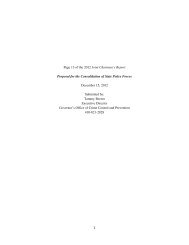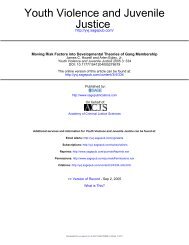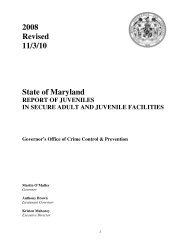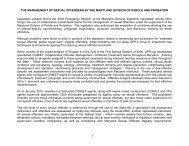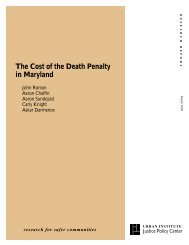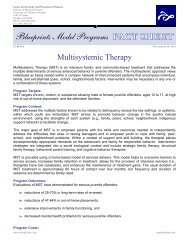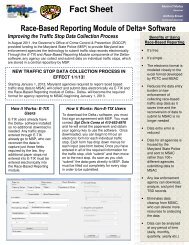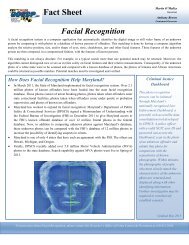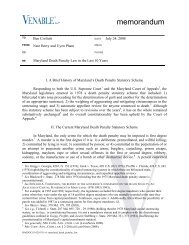Targeted Outreach - Governor's Office of Crime Control & Prevention ...
Targeted Outreach - Governor's Office of Crime Control & Prevention ...
Targeted Outreach - Governor's Office of Crime Control & Prevention ...
You also want an ePaper? Increase the reach of your titles
YUMPU automatically turns print PDFs into web optimized ePapers that Google loves.
32 <strong>Targeted</strong> <strong>Outreach</strong><br />
Contact with Collaborating Agencies<br />
The network <strong>of</strong> agencies with which Clubs collaborated<br />
in implementing GPTTO and GITTO was extensive.<br />
Figure 2 shows the frequency with which the<br />
prevention Clubs contacted different organizations. In<br />
general, Clubs had the most frequent contact with<br />
schools and families—all but two Clubs noted at least<br />
monthly contact, and 5 and 7 Clubs noted daily contact<br />
with schools and families, respectively. We also<br />
gathered data to assess the extent to which prevention<br />
Clubs showed an increase in the frequency <strong>of</strong> contact<br />
they had after implementing GPTTO. 16 Indeed, 19 <strong>of</strong><br />
the 21 prevention Clubs noted an increase in contact<br />
with at least one agency. The greatest number <strong>of</strong> Clubs<br />
(12 <strong>of</strong> 21) saw the most increase in contact with the<br />
police. The Clubs indicated that they received and followed<br />
up on referrals from the police, in addition to<br />
obtaining tracking information on youth and receiving<br />
general information about crime rates and gangs<br />
statistics. Just under half <strong>of</strong> the Clubs (10 <strong>of</strong> 21) noted<br />
an increase in the frequency <strong>of</strong> contact they had with<br />
schools and counseling services, although the other<br />
half <strong>of</strong> the Clubs reported already having had those<br />
relationships in place.<br />
Fourteen <strong>of</strong> 21 Clubs attributed this increase to<br />
newly established contacts with outside agencies. The<br />
total number <strong>of</strong> new contacts these 14 prevention<br />
Clubs established ranged from one to five, with an<br />
average <strong>of</strong> three new outside agency contacts per<br />
Club. The greatest number <strong>of</strong> Clubs (7 <strong>of</strong> 21) established<br />
new relationships with probation agencies.<br />
Figure 3 displays the contacts intervention Clubs had<br />
with outside agencies. For intervention Clubs, collaboration<br />
with outside agencies was essential to getting<br />
the projects <strong>of</strong>f the ground. For example, one project<br />
developed in conjunction with the local police;<br />
another project evolved from a city, county and local<br />
law enforcement effort to deal with a rash <strong>of</strong> gang<br />
shootings; the third was a product <strong>of</strong> meetings<br />
between the Club and a local judge wishing to provide<br />
an alternative to traditional probation. Figure 3 clearly<br />
indicates that contact with outside agencies was an<br />
integral piece <strong>of</strong> the intervention strategies, and this<br />
reflects the difference in population the intervention<br />
Clubs served. All three intervention Clubs had contact<br />
with each agency at least quarterly.<br />
Advantages and Challenges <strong>of</strong> Establishing and<br />
Maintaining Partner Relationships<br />
Interagency collaboration is integral to the Clubs’<br />
ability to recruit and monitor youth. When the relationships<br />
develop and work well, Clubs and collaborators<br />
see multiple benefits to the partnerships.<br />
During visits to intervention and prevention sites, we<br />
interviewed representatives from partner agencies<br />
and heard about the advantages each saw. The partner<br />
agencies had begun to view the Club as a<br />
resource for them and a place to help youth who<br />
<strong>of</strong>ten fall between the cracks. One advantage noted<br />
by a provider at an intervention Club was that the<br />
relationship between the staff and youth made it easier<br />
for her to engage the youth’s trust.<br />
Additionally, the provider noted that the collaborative<br />
made it easier for the agencies to “wrap” the<br />
services around the youth, rather than expect the<br />
youth to be able to get transportation to multiple<br />
needed services, such as for job training, GED, and<br />
drug and alcohol treatment. At this and other Clubs,<br />
service providers came on site to work with youth.<br />
The Club’s facility and the fact that the programming<br />
was primarily place-based provided multiple<br />
opportunities for integration and cooperative provision<br />
<strong>of</strong> services. For example, at one prevention<br />
Club, as a result <strong>of</strong> the relationship that developed<br />
between probation and the Club, a probation <strong>of</strong>ficer<br />
used Club space during the day for an alternative<br />
high school program. Youth in the alternative high<br />
school were then encouraged to participate in Club<br />
activities and eventually join.<br />
Police <strong>of</strong>ficers and probation <strong>of</strong>ficers also valued the<br />
time they spent at Clubs, talking to Club staff. For<br />
example, several probation <strong>of</strong>ficers in different cities<br />
said they would <strong>of</strong>ten drop by the Club to play basketball<br />
with the youth. Probation <strong>of</strong>ficers also found<br />
it helpful to be able to get in touch with the youth at<br />
the Club or find information about where they might<br />
find the youth. Additionally, a probation <strong>of</strong>ficer with<br />
whom we spoke in one intervention program indicated<br />
that the Club became a place where younger<br />
youth can fulfill their community service hours and,<br />
at the same time, fit in. At Clubs with strong relationships<br />
with probation or police, Club staff are best<br />
able to track whether youth are getting into trouble.<br />
These Clubs also typically tend to reach more<br />
GPTTO youth who had already had contact with the<br />
justice system.



